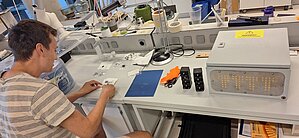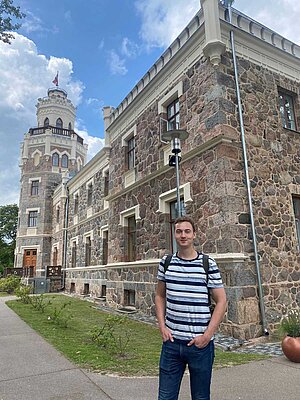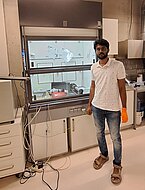Oleksandr Solodovnyk
Viktorija Liustrovaite
Marina Sapauskiene
Ines Marques
Vipin Kumar Veeramuthu
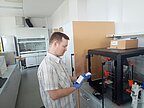

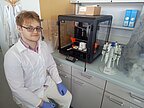
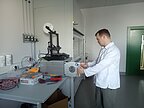

Dr. Mykola Pavlenko and PhD student Andrii Lys from AMU (Poznan, Poland) visited VU (Vilnius, Lithuania) from August 5th to September 4th, 2024.
During the visit in the frame of the Horizon Europe MSCA-SE project “Electro-conductive Polymeric 3D Scaffolds as Novel Strategies for Biomedical Applications” (ESCULAPE), Dr. Mykola Pavlenko and PhD student Andrii Lys received scientific training in the synthesis of noble metal nanoparticles and conducting polymer layers. Deposition of MXene-based electrodes for subsequent electrochemical analysis involved the preparation and optimization of MXene-based electrodes to ensure their effectiveness and stability across various applications.
Aleksi Kuivisto from the University of Eastern Finland (Itä-Suomen yliopisto) visited the Institute of Electronics and Computer Science (EDI) from July 1st, 2024, to July 30th, 2024.
During a one-month visit in the frame of the Horizon Europe MSCA-SE project, “Electro-conductive Polymeric 3D Scaffolds as Novel Strategies for Biomedical Applications” (ESCULAPE), measurement of the electrical conductivities of MXene-based electrospun scaffolds was carried out. As the first step, experiments to study the electrical conductivity development of MXenes after dip coatings. Here, the technique developed in UEF, Electrical impedance tomography (EIT), was used in EDI to overcome preliminary tests conductivity evaluation challenges based on MXenes inhomogeneous after scaffold coating.
From June 9th to August 8th, 2024, PhD student Katazyna Blazevic visited Uniwersytet im. Adama Mickiewicza w Poznaniu.
The purpose of the secondment was the development and optimization of MXenes nanocomposites using various coating techniques, followed by optical and electrochemical characterization.
During the secondment, Katazyna Blazevic learned about layer formation by spray coating technique for MXenes and the MXene-TiO2 composite. To assess the deposition of nanocomposite layers on the surface, the photoelectric characteristics of these layers were examined. The characterization of the produced layers was performed by employing photoelectrochemical, optical, SEM, and EDX techniques.
Optimal conditions for layer formation by the spray coating technique were determined and achieved. Promising results were obtained, showing a substantial increase in photocatalytic activity compared to pure TiO2 nanowires.
In future works, MXene nanocomposite deposition by spray coating technique can be used to deposit such nanocomposites on the polymeric membranes.
Anton Popov visited the NanoBioMedical Center, AMU (Poznan, Poland) from June 9, 2024 to July 8, 2024.
During the secondment, work on the synthesis and characterization of MXenes Ti3C2Tx was carried out. In addition, the deposition of MXenes by different methods on the electrode surface was studied. Electrochemical measurements were used to investigate the electrodes modified with the Ti3C2Tx MXenes layer. The optimal deposition parameters of MXenes layers were selected.
Dr. Anton Popov imparted knowledge on the synthesis and characterization of MXenes. Intensive training on spray coating techniques for the deposition of MXenes layer on different surfaces was carried out. The results obtained will be useful for the future deposition of MXenes on polymer membranes.
From 8 April to 7 August 2024 Vipin Kumar Veeramuthu visited University of Latvia.
During a four-month secondment at the University of Latvia, the assembly and commissioning of an electrospinning unit was successfully completed. This included the integration of key components such as pumps and collectors, all of which were sourced directly from LINARI ENGINEERING SRL, Italy. Rigorous testing ensured that the system operated seamlessly and achieved optimum performance.
This was followed by the selection of specific solution parameters, including solvent types, concentrations and nanofiber electrospinning processing conditions. These parameters were carefully selected to develop polymer solutions using polycaprolactone (PCL), polylactic acid (PLA) and chitosan tailored for the production of 3D electrospun membranes. Using conventional, multi-needle and coaxial electrospinning techniques, the desired membrane morphology and properties were achieved through careful manipulation of solution parameters and electrospinning conditions.
Finally, after numerous experiments and analyses, the 3D electrospun PCL membranes with the desired properties were prepared and can be used for experiments with MXenes. Other polymers were still being optimized to obtain perfect membranes and this will be continued in the next period of secondment.



Prof. Aku Seppänen from the University of Eastern Finland (UEF, Finland) visited the Institute of Electronics and Computer Science (EDI, Latvia) from May 1st, 2024 to May 15th, 2024.
The visit in the frame of the Horizon Europe MSCA-SE project “Electro-conductive Polymeric 3D Scaffolds as Novel Strategies for Biomedical Applications” (ESCULAPE) was devoted to MXenes testing including monitoring of MXenes conductivities in varying humidity conditions, effect of materials used in MXenes to its conductivity (e.g. use of Niobium (Nb) or Vanadium (V) instead of Titanium), the effect of Ti flake size in the solution to the MXenes conductivity and monitoring of the MXenes degradation process.
From 11 to 25 April 2024 Dr. Volodymyr Deineka visited the Vilniaus universitetas, Vilnius, Lithuania.
The visit aimed to conduct a structural description of the Ti3C2 and Nb2C Mxenes. Data between these two types of MXenes will be compared, and patterns of characteristics associated with the size of nanoparticles will be determined. During the implementation, Dr. Deineka received intensive training on working with SEM. The Vilniaus universitetas staff demonstrated best practices in studying nanomaterials.
After obtaining the structural characterisation results, the data were discussed to select the best samples to be coupled to the nanofibrous 3D membranes. Dr. Deineka demonstrated different types of polymer membranes obtained by electrospinning and spoke about the features of producing these materials. As a result of the discussion, the optimal parameters of the membrane were selected as a scaffold for applying Mexene.
The results of the visiting studies will be used in further studies of polymer-MXene membranes on experimental models in vitro.
From 21 February to 20 April 2024, Dr. Sergiy Kyrylenko from the Sumy State University conducted a research secondment to Universidade Estadual de Campinas (Unicamp). During the secondment, the electro-conductive polycaprolactone (PCL) electrospun nanofibrous membranes with Ti3C2 MXene surface layers, produced by the Sumy State University in collaboration with Materials Research Centre – MRC, were first tested in the conditions in-vivo to support neuronal regeneration in animal model of sciatic nerve injury in rats. To obtain more reliable and reproducible results, the similar membranes were produced also at the University of Latvia in Riga, Latvia.
At the Unicamp, together with Prof. Alexandre Oliveira and his team, a series of experiments were conducted to investigate how neuronal conduits, made out of MXene covered PCL nanofibrous membranes, could be used in design of neuronal conduits to support regeneration of sciatic nerves in the animal model of neuronal injury in rats. For this, the sciatic nerve was dissected and sutured by neurorrhaphy in conjunction with axon fusion technique. Functional recovery was monitored by CatWalk system during 4 weeks post operation. After that, the neuronal fibers together with the conduits and surrounding tissues were examined and prepared for transmission electron microscopy (TEM) investigations.
As a result, while the data processing is still in progress, it was showed that the functional regeneration occurred much faster than after the traditional neurorrhaphy. Importantly, it was also observed that the new conduits did not induce adverse accumulation of connective tissues at the site of treatment. Currently, experiments are in progress to show the microstructure of the axonal fusion and the state of the MXenes and the PCL nanofibers after 4 weeks in the animal’s body. In addition, currently a second series of experiments are planned to investigate functional recovery during 8 weeks post operation, as well as histological examination of the treatment sites.
From 25 November to 8 January 2024 Dr. Sergiy Kyrylenko visited Department of Technical Physics, University of Eastern Finland in Kuopio (Itä-Suomen yliopisto), Finland.
The visit started with intensive exchange of knowledge in the truly interdisciplinary fields. The objective of the visit was to evaluate if the technique of electric impedance tomography could be applied to study conductivity of the polymer-MXene membranes. As a result, the experimental setup was brainstormed and the design of the experiment was put together. To the best of our knowledge, that was the first approach to evaluate the spatial distribution of the conductivity of the polymer-MXene membranes.
Despite the extreme winter weather conditions, the visit was a complete success. During the visit the secondee received training in non-destructive electrical imaging techniques, while the host Department obtained new directions in working with MXenes and other nanoparticles. The research results of the visit will be utilised in the further investigations of the polymer-MXene membranes in the in-vivo experimental models.

 Academic Centre
Academic Centre